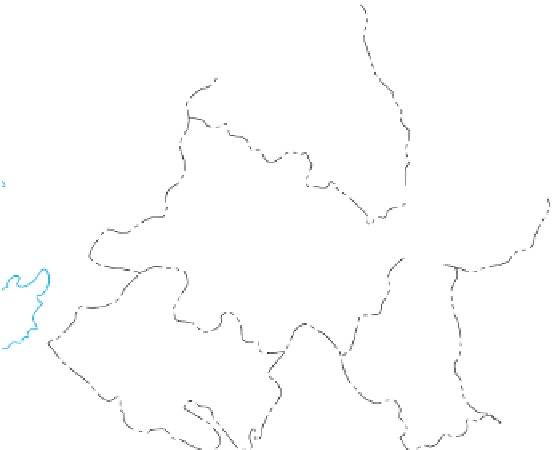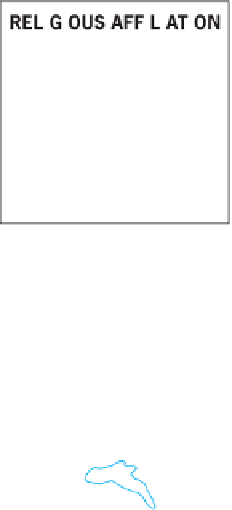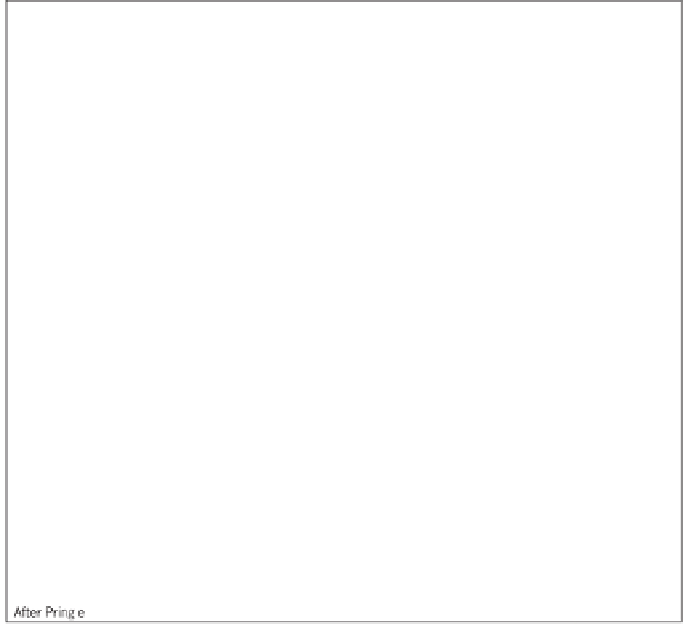Geography Reference
In-Depth Information
Figure 7.39
Religious Affi liation in Northern Ireland.
Areas of Catholic and Protestant majorities
are scattered throughout Northern Ireland.
Adapted with permission from
: D. G. Pringle,
One Island, Two Nations?
Letchworth: Research
Studies Press/Wiley, 1985, p. 21.
Ireland was sensitive to the plight of Catholics in the
North, no offi cial help was extended to those who were
engaging in violence.
In the face of worsening confl ict, Catholics and
Protestants in Northern Ireland increasingly distanced
their lives and homes from one another. The cultural land-
scape marks the religious confl ict, as each group clusters
in its own neighborhoods and celebrates either important
Catholic or Protestant dates (see Fig. 6.11). Irish geogra-
pher Frederick Boal wrote a seminal work in 1969 on the
Northern Irish in one area of Belfast. Boal used fi eldwork
to mark Catholic and Protestant neighborhoods on a map,
and he interviewed over 400 Protestants and Catholics in
their homes. Boal used the concept of
activity space
to
demonstrate how Protestants and Catholics had each cho-
sen to separate themselves in their rounds of daily activity.
Boal found that each group traveled longer distances to
shop in grocery stores tagged as their respective religion,
walked further to catch a bus in a neighborhood belong-
ing to their own religion, gave their neighborhood differ-
ent toponyms, read different newspapers, and cheered for
different football (soccer) teams.
Although religion is the tag-line by which we refer to
“the Troubles” in Northern Ireland, the confl ict is much
more about nationalism, economics, oppression, access to
opportunities, terror, civil rights, and political infl uence.
But religion and religious history are the banners beneath
which the opposing sides march, and church and cathe-
dral have become symbols of strife rather than peace.
In the 1990s, Boal updated his study of Northern
Ireland and found hope for a resolution. Boal found that
religious identities were actually becoming less intense
among the younger generation and among the more
educated. In Belfast, the major city in Northern Ireland,
Catholics and Protestants are now intermixing in spaces
such as downtown clubs, shopping centers, and college
campuses.
Boal's observations proved to be right, and a move-
ment toward resolution among the population along
with the British government's support for devolution (see
Chapter 8) helped fuel the April 1998 adoption of an Anglo-
Irish peace agreement known as the Belfast Agreement
& Good Friday Agreement, which raised hopes of a new
period of peace in Northern Ireland. Following a decade
of one step forward and two steps back toward peace,
Northern Ireland fi nally realized a tenuous peace in 2007
when the Northern Ireland Assembly (Parliament) was
reinstated. The two sides have made major strides toward
reconciliation in recent years, but the confl ict has not gone
away. While some of the younger generation may be mix-
ing socially, more “peace walls” (giant barriers between
Catholic and Protestant neighborhoods) have been con-
structed since the signing of the Belfast agreement—raising
concerns that segregation may be increasing.



































































































































































































































